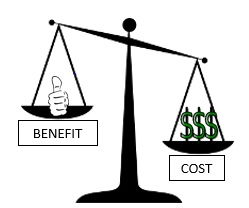As you probably observed weekend, maximizing treats and minimizing tricks is a primary objective of the annual Halloween ritual; as is the case when making decisions. A properly performed Cost Benefit Analysis (CBA)  maximizes the high value information you take in and minimize the low value information to increase the odds of making sound decisions, which can lead to subsequent achievement of desired outcomes. If not handled correctly, CBAs can cause poor decisions that can turn your financial house into a house of horrors. Having a credible, sound CBA can prevent decision makers from holding a bag full of rocks, like our friend Charlie Brown had to endure.
maximizes the high value information you take in and minimize the low value information to increase the odds of making sound decisions, which can lead to subsequent achievement of desired outcomes. If not handled correctly, CBAs can cause poor decisions that can turn your financial house into a house of horrors. Having a credible, sound CBA can prevent decision makers from holding a bag full of rocks, like our friend Charlie Brown had to endure.
Based on our experiences, here are seven considerations and best practices for CBAs.
Best Practices
- “Big Picture” for clarity – The late Yogi Berra once said “If you don’t know where you’re going, you’ll wind up somewhere else.” To that end, it’s critical to start from 10,000 feet up to grasp the big picture of the CBA. A sound CBA communicates immediately identifies the main parts of the action or decision that is the subject of the CBA. The strategic business objectives the project aligns to, the reason for the CBA, and the selection criteria and their relevance to the purpose of the CBA need to be sufficiently considered, defined, and specified before identifying costs and benefits.
- Consistent and accurate Time Line – I’ve performed CBAs that look into the future across weeks, years, and even a couple of decades. Stakeholders need to see the timing and variation of the individual benefits and costs across the time period. Further, the period of analysis should be consistent among alternatives, and discrepancies clearly and fully reconciled and explained. When results of the CBA are seen along a timeline, decisions can be better made to maximize ROI through cost reduction, cost postponement or avoidance, gain increase, or acceleration.
- Breadth and depth of assumptions and methods – Numbers alone don’t tell the full story. Decision makers and stakeholders need to see the assumptions and methods, which is the basis of estimate, behind the CBA. They need to be able to discern the data and the manner in which it was collected, normalized, and examined, to ensure proper meaning.
- Comprehensive inclusion of benefits and costs – Many CBAs lack validity or creditability because they omit important benefits or costs from the scope of the study. So called “soft benefits” such as strategic value, morale, or customer experience can be more difficult to defend, to the extent that many don’t include many of them in the study. This can be a mistake. Since they sometimes are more applicable or meaningful in a study. The key is to quantify them using a rationale, systematic scale for measurement and tangibility. Also, implementing the scale thoughtfully through a carefully composed IPT can help ensure meaningful results.
- Does the CBA discuss critical success factors? – Assumptions identified during the study that can be managed or influenced to some extent are critical success factors (CSFs), which affect the results of the selected project or alternative. It’s best to move beyond simply stating the obvious (“benefits exceed costs”) and include “recommendations” that identify the CSFs to manage through implementation plan.
- Are risks and opportunities identified and quantified? – Point estimates (i.e. most likely outcomes) are rarely reliable. Therefore, it’s critical to assess a range of potential outcomes. Further, a deeper understanding of how a change in the values of specific drivers (i.e. market size, software size, economic trends) can impact the overall estimate is needed. Because these assumptions are all uncertain to some degree, performing sensitivity and risk analyses can yield greater insight into the uncertainties. Sensitivity analysis reveals which assumptions are most important in impacting overall results; risk analysis reveals the probability of other outcomes.
- Is the estimate documented and portrayed clearly and fully using appropriate tools? – A well-documented cost estimate is a characteristic of high-quality CBAs. To ensure a CBA can be easily updated and replicated, it is important to create a basis of estimate (BOE) that defines the source data used and their significance, the calculations performed and their results, and the rationale for choosing a particular estimating method or reference. There are many commercial tools available in the marketplace to facilitate the development of the estimate, including MS Office and ACE IT. More information on cost estimates can be found on the GAO website.
What tricks or treats have you experienced with CBAs?



